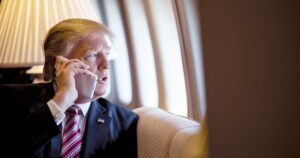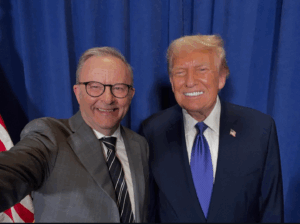There is a depressing honesty about Donald Trump’s announcement that the United States will withdraw from the Paris climate agreement. It stands in stark contrast to the hypocrisy of Malcolm Turnbull’s big talk on climate change, which is accompanied by a $1 billion subsidy for the enormous new Adani coal mine. At least Trump is doing what he said he would do.
[This article was first published by The Canberra Times – here]
Trump shows his contempt for the world’s problems by withdrawing from a global agreement on the basis that he doesn’t think it’s in his nation’s interest, while Turnbull shows his contempt by remaining in that same agreement while funding the construction of a new coal mine that will still operate in 2080. Which is worse?
The “business case” for Turnbull’s coal line from the Adani mine to the Great Barrier Reef is that five other major coal mines will also be built in the Galilee basin. In the words of Resources Minister Matt Canavan, “what I’d expect to see, with the federal government wanting to open the Galilee basin, is that the rail line’s open access that other mines can use it and that we can, by building, connecting up a new coal basin in our country, create wealth, not just in one individual project but right across the board, that’s what we’d like to see”. Combined with the Adani mine, the other mines Canavan referred to would together produce 300 million tonnes of coal a year.
To put Turnbull’s coal expansion plans into context, Australia is already the world’s largest coal exporter. At 388 million tonnes in 2015-16, we have a larger share of the traded coal market than Saudi Arabia has of the world oil market. And the Australian government hopes to facilitate a doubling of our coal exports.
Think about that. Australia is a signatory to an international agreement to reduce greenhouse gas emissions to zero in 33 years’ time. And Turnbull wants to subsidise the opening-up of a new coal basin in the hope that it will export an extra 300 million tonnes of coal a year. I’d take Trump’s denial over Turnbull’s deception any day.
The Coalition clearly takes the adage that, if you are going to tell a lie, tell a big one quite seriously. Having decided to adopt a bizarre “pro-coal, pro-climate” public position, it has set out to abuse language, policy and taxpayers’ money to design a bridge between the multiple sandcastles it is building in the air. Take this week’s announcement that more taxpayers’ money will potentially be invested in “carbon capture and storage”.
Like cold fusion, and healthy cigarettes, coal-fired power stations that can capture their pollution and pump it safely underground have promised big and delivering nothing for decades. But such fantasies are central to the political strategy of those who want to defend the status quo while promising change. How can Australia double its coal exports and support climate action? Easy! We’ll invent “clean coal”. The fact that taxpayers fund the coal industry cover story is just icing on the cake.
Speaking of defending that status quo, on the domestic front, the Coalition’s direct action plan is reaching its use-by date and the Turnbull government is faced with the impending arrival of a new report by Chief Scientist Professor Alan Finkel. It’s the latest in a string of government reviews of the need for a long-term climate policy that can actually put some pressure on polluters to reduce their emissions rather than put putting pressure on the budget to buy emission reductions.
The Chief Scientist’s problem is not the scientific or economic challenges of building a new electricity grid based on new generation and storage technologies. Those problems are easy compared to the linguistic and political “barriers” to bringing our energy system into the 21st century.
Obstacle No. 1 is that the Coalition can’t possibly introduce a simple and effective carbon tax. The idea that a government would introduce a tax to discourage a harmful activity has become anathema to the “good economic managers” in the Coalition, even if it is economics 101. And even if Tony Abbott increased tobacco taxes to discourage smoking.
Obstacle No. 2 is the Coalition’s inability to introduce anything that “looks like a carbon tax”. This apparently rules out any notion of emissions trading, in which a government sells a limited number of tradable permits to polluters. Needless to say, the Coalition has never described the tradable free-to-air TV licences it sells as a “television tax” although, hey, who knows, maybe that’s coming next.
Obstacle No. 3: you can’t propose a scheme like an emissions intensity scheme (or EIS) in which the government never raises a cent. Under an EIS, the government sets a target level of “emission intensity” and any electricity generators whose emissions intensity (tonnes of CO2 per unit of electricity produced) is above the target must buy “credits” from generators whose intensity is below the target. Needless to say, the notion you can’t slug some industry participants who misbehave is odd coming from a government that just introduced a “bank levy” on the big banks.
Australia has a larger share of the traded coal market than Saudi Arabia has of the world oil market.
So what might Finkel advise? If we start from the assumption that, these days, “independent reviews” take the arbitrary and self-imposed political constraints of governments seriously, it’s unlikely he’ll strongly recommend any of the simple and effective options described above.
A fourth option is a low emissions target (or LET) to augment, or replace, the effective renewable energy target (RET). The RET, first introduced by John Howard, requires electricity retailers to source a fixed amount of electricity from renewables. It helped drive down the cost of renewable energy and, according to modelling commissioned by Tony Abbott, lowered electricity costs, too. The only “problem” with the RET is that, in setting aside a minimum market share for renewables, it sets a maximum market share for fossil-fuel generators. While the Nationals like to lead the charge against the “distortionary” RET, they are the driving force behind the NSW laws that force drivers to buy petrol blended with a fixed proportion of ethanol.
While the RET specifies that electricity retailers must buy energy from wind and solar, a LET could potentially require electricity generators to source their “low emission” electricity from gas or nuclear as well. While including gas and nuclear on the list of eligible sources of “clean” fuels is an obsession for some who think that climate policy should be “technology neutral”, the reality is the high cost of gas and nuclear energy probably means that a LET and a RET are similar policy beasts. Needless to say, many of those who say renewables should need to compete without subsidies on a “level playing field” are strategically silent about the Commonwealth subsidies required to open up the Galilee coal basin.
The fact is the acronym by which our climate policy is known is far less significant than the ambition, and legislative detail, on which it is based. Put simply, there is more room for variation within the possible climate policies than there is between them.
Trump’s clear repudiation of the US’s commitment to tackle climate change and Turnbull’s cynical pretence of support for climate action both point to the same obvious conclusion. Until the world stops building new coal mines and stops building new coal-fired power stations, the world’s emissions will continue to grow. Everything else is just a cover story for our failure to act.
Richard Denniss is The Australia Institute’s chief economist. Twitter: @RDNS_TAI
Between the Lines Newsletter
The biggest stories and the best analysis from the team at the Australia Institute, delivered to your inbox every fortnight.
You might also like
Donald Trump cannot make the Epstein files go away. Will this be the story that brings him down?
Conspiracy theories are funny things. The most enduring ones usually take hold for two reasons: first, because there’s some grain of truth to them, and second, because they speak to foundational historical divisions. The theories morph and change, distorting the grain of truth at their centre beyond reality. In the process, they reinforce and deepen
It shouldn’t be this difficult to condemn plans to commit a crime against humanity
Australians, by and large, have seen America as an ally critical to our national security. But in just a few short weeks, Donald Trump has shown his administration is a threat to Australia and the world’s security. Australia may not be able to stop Trump from creating chaos, but we will undermine our own security if we don’t stand up for ourselves and for our values.
Can Albanese claim ‘success’ with Trump? Beyond the banter, the vague commitments should be viewed with scepticism
By all the usual diplomatic measures, Australian Prime Minister Anthony Albanese’s meeting with US President Donald Trump was a great success. “Success” in a meeting with Trump is to avoid the ritual humiliation the president sometimes likes to inflict on his interlocutors. In that sense, Albanese and his team pulled off an impressive diplomatic feat. While there was one awkward



